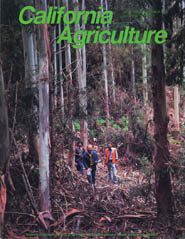All Issues

Cover:
A 160-acre 20-year old plantation of Eucalyptus viminalis (manna gum) in Slaughter House Gulch in Mendocino County was a recent venture to commercialize eucalyptus in California. Current research by the University of California in short rotation intensive culture has improved selection and management of eucalyptus, increasing its potential for fuel and pulpwood.
November-December 1988
Volume 42, Number 6
Volume 42, Number 6





